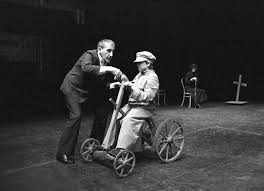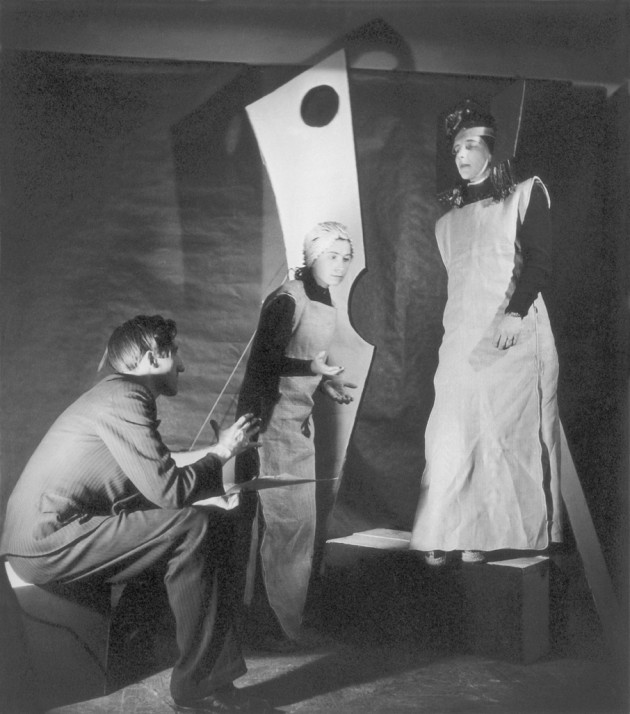Who is the “heir” of Tadeusz Kantor?
I do not know how to answer this question because any attempt to answer it requires defining – or limiting – radically diverse creative activities of Tadeusz Kantor that were happening in changing socio-political-cultural contexts between the 1930s and 1990.
Tadeusz Kantor was a Polish director, scenographer, performance artist, visual artist, performer, and educator. Born in Wielopole Skrzyńskie in 1915, he studied in Kraków’s fine art academy. During WWII – in Kraków under the Nazi occupation – he created the Clandestine Theatre. There, he developed foundations of his future creative praxis, in particular his Theatre of Death – in which he explored post-trauma, post-memory, and experiences of death in relation to his biography, Holocaust, Poland’s history and Jewish history – and his exploration of the relationship between humans and objects on stage. His 1975 Umarła Klasa (Dead Class) – his most famous work – presents old people returning to their school, carrying mannequins symbolizing their young selves, the school bags, and, in some cases, objects performing their traumas. Despite running his theatre group Cricot 2, he remained active as a visual and performer artist, and scenographer, lecturing at the Academy of Fine Arts in Kraków.
This short biography cannot reflect the richness and diversity of his work. Perhaps the different contexts in which his influences on contemporary art and theatre have been discussed can do that better. Some scholars, such as Manuel García Martinez, see Kantor’s influence on the Kraków-trained director Krystian Lupa. Katarzyna Fazan shows his on Poland’s contemporary art scene. Polish playwright Tadeusz Słobodzianek references Dead Class in his play Nasza Klasa (Our Class, 2009), which explores Polish-Jewish relations in the twentieth century. Direct references to Dead Class are also in Robert Wilson’s works, for example, in his famous Peter Pan, which departs from the idea that the only way for Peter Pan to remain a child was to die as a child.

In Magda Romanska and Kathleen Cioffi’s Theatermachine Tadeusz Kantor in Context, Kantor’s influences have been traced in French, German and American Avant-Garde works by Agnieszka Tworek, Herda Schmid, and Lauren Dubowski respectively. Romanska and Cioffi’s collection also considers Kantor’s work as a theoretical proposal that impacted contemporary cultural thought, including new materialism, post-memory, and posthumanism.
Theatre scholar Hans-Thies Lehmann in his iconic 1999 Postdramatic Theatre pointed to Kantor as one of the leaders in foregrounding new forms of theatre that emerged in the twentieth century and, as Lehmann argued, shifted the idea of what theatre is. In this sense, postdramatic theatre artists such as the Wooster Group, Forced Entertainment, Romeo Castellucci, or Pan Pan can also be seen as the heirs of Kantor. The Wooster Group openly marks these references.
Kantor’s exploration of non-human agency underpins some works on virtual reality, while his international status inspired works on migration. International Theatre Company Reykjavík Ensemble – founded in 2019 by Iceland-born director Pálína Jónsdóttir and Polish-born Ewa Marcinek – is a platform for multinational theatre makers to celebrate their diverse origins and languages. Their 2020 project Ég kem alltaf aftur/I Shall Always Return references and explores the work of Kantor. The context is his 1990 visit at the Reykjavík Arts Festival to perform his last finished show Nigdy tu już nie powrócę (I Shall Never Return) as well as the experiences of Polish migrants living in Iceland in the twenty-first century.
And there is, of course, Kantor’s archive Cricoteka, founded by the artists in 1980 in Kraków as a living archive of the Cricot 2 Theatre, and now a cultural organization that facilitates different artists’ engagement with Kantor’s ideas. They host activities ranging from concerts, performances to workshops for children. During summer 2024, for example, Cricoteka will present a series of sound installations designed for its building that explore how sound shapes and reshapes spaces and places.

How diverse Kantor’s influences are (and how impossible it is to point his heir) is well exemplified by how his idea of bio-objects functions in contemporary theatre. Kantor’s bio-objects are based on a symbiosis between live and artificial agencies, which is often imagined in his work as a symbiosis between actors and objects. The deepness of the actor-object connection runs so deep that the two become inseparable, as if each other’s organs. The actor’s aliveness makes the object “alive,” gives it agency. But without the object, the actor cannot exist on stage; the actor’s stage agency depends on the object. This raises questions of agency and aliveness (for more, see Kobiałka). Who has more agency and/or who has more “aliveness”, objects or humans? In Umarła Klasa (Dead Class) mannequins are carried by the actors, symbolizing their youth, a woman appears on the stage through a window frame that she carries. The frame is fused into her body, that is the only way she exists on stage.
In contemporary Polish theatre, inspiration from bio-objects can be seen in the works of Wierszalin. The Supraśl (near Białystok in north-east Poland) theatre company was co-founded in 1991 by director Piotr Tomaszuk and playwright Tadeusz Słobodzianek (the author of already mentioned Nasza klasa). Tomaszuk is a graduate of Białystok’s puppetry directing department at the Theatre Academy, within which the theatre of objects, in which objects are full performers, is an essential element of training. Tomaszuk openly speaks about his Kantor’s influences, both artistically (by “borrowing” characters from Kantor’s work) and by speaking about his inspirations with bio-objects in how wooden figures exist in Wierszalin:
Figure in our theatre was supposed to be more real than human, it was supposed live its own life, create its own “theatre within theatre.” (Tomaszuk, my translation)
This is visible in many shows, as critics like Jacek Sieradzki or Kamila Łapicka pointed out. An undeniable example is the 2007 Wierszalin. Reportaż o końcu świata (Wierszalin. The Report on the End of the World) based on a reportage book by Włodzimierz Pawluczuk. The production explores the nature of faith in miracles through histories from the region near the Polish-Belarusian border and its prophet Ilja. In Tomaszuk’s production, the audience can trace direct quotations from Kantor: white-painted faces, wooden scenography and crosses-as-bio-objects (recalling Wielopole Wielopole), and a woman behind the window frame.
The idea of bio-objects has travelled far and has been applied beyond the materiality of objects. For example, British artist-scholar Andy Hurst explore light as a bio-object in his 2014 Etched. In Polish theatre, the application of bio-objects beyond the common understanding of “an object” can be seen in the work of Anna Augustynowicz.
Anna Augustynowicz is one of the most renowned Polish directors, and the Artistic Director of Współczesny Theatre for two decades. She works closely with actors, seeing them as partners that she credits for the success of her productions (Cieślak 57). Augustynowicz often limits the visual elements of her staging, highlighting the theatricality of the performances and the live presence of the actors and the audience. The importance of soundscapes is typical of her shows, and she calls music her ‘partner’ in the creative process of live performance (Augustynowicz): music, often very loud, regularly creates a counterpoint to the very intentional soundscape created by the voices and bodies of the actors performing. Like the objects in Kantor’s work, soundscape is integrated in Augustynowicz’s acting ensemble bodies that both produce it and is animated by it.
According to Augustynowicz, work on the vocal soundscape starts when the actors read the play aloud. She compares this moment to the reading of a musical score:
The actor takes a text which is foreign for him as his own, and creates it as his own; he becomes an instrument and instrumentalist conjoined in one person. The sounds of personae are often precisely inscribed within the play. (Augustynowicz, my translation).
Migrena(2010) shows it well. In it, Augustynowicz explores connections between language and the circle of oppression in meat-eating and sexual consumption. Her actors speak and move mechanically as if detached from emotions; they use various elements of scenography to beat the rhythm to which other actors move. Together, they perform a living structure of an anthro-patriarchal society in which the oppression of women and animals are interconnected.
Augustynowicz’s references to Kantor also arise from her collaboration with scenographer Marek Braun. They directly referenced Kantor’s Wielopole, Wielopole in 2023 staging of Stanisław Wyspiański’s Sędziowie (Judges) at the Aleksander Fredro Theatre in Gniezno. But, as pointed out by Dariusz Kosiński, this reference is bitterly ironic and political, commenting on the desolation of the patriarchal world (Kosiński).
The reason why Kantor’s idea of bio-object appeals to contemporary artists is perhaps the question of non-human agency. In the era of AI, technology, and material waste of objects humans no longer need (and yet speed up climate change), the issue of who has the agency over whom seems urgently relevant. No wonder these questions, while maybe not directly inspired by Kantor, are also posed by drama schools, especially puppetry departments in Wrocław and Białystok, where future theatre artists train. The biannual international conference LALKA NOVA brings puppeteers (also those in training), other artists, and scholars to explore theatre of form, the question of the aliveness of materiality in relation to the newest technological developments, and the cyber revolution. Similar themes appear during LALKANIELALKA (PUPPETNOPUPPET), the biannual International Festival of Puppetry Schools in Białystok. The festival brings together established and in-training artists to explore tradition and the newest artistic trends in puppetry, as the art of making not-alive appear as alive…
Works cited
Augustynowicz, Anna. „Gra w muzykę.” Teatr, 9, 2008.
Cieślak, Robert. Teatr Anny Augustynowicz. Wydawnictwo Naukowe Uniwersytetu Szczecińskiego, 2011.
Kobialka, Michal. Further on, Nothing: Tadeusz Kantor’s Theatre, University of Minnesota Press, 2009.
Kosiński, Dariusz. Sędziowie Anny Augustynowicz. Tygodnik Powszechny, 25, 2023.
Romanska, Magda and Kathleen Cioffi (eds.). Theatermachine Tadeusz Kantor in Context. Northwestern University Press, 2020.
Tomaszuk, Piotr. „Teatr to coś ostatecznego.” Teatr, 5, 2007.